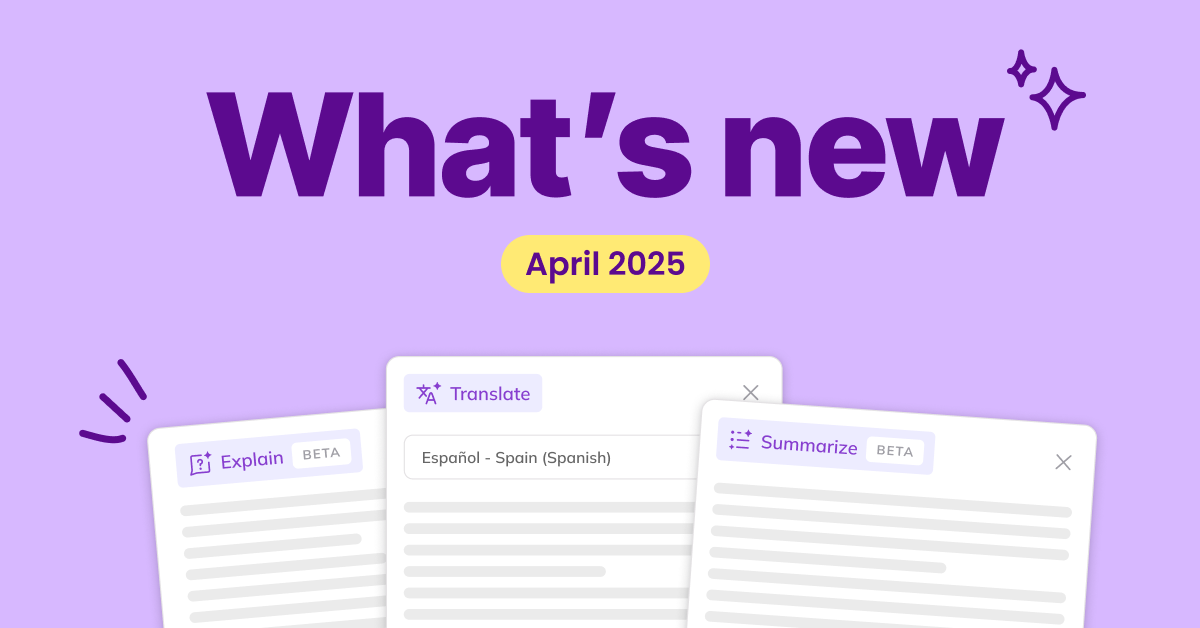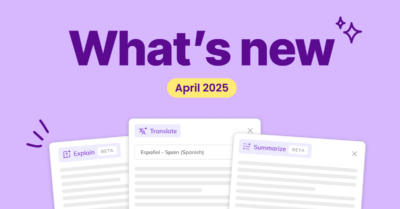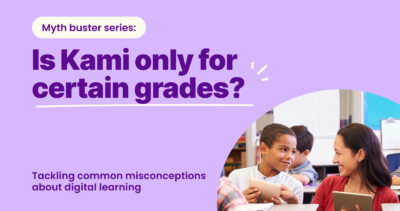Unlocking understanding: Kami’s latest updates designed for every learner

Becky Simms
Teachers know that comprehension is the gateway to learning. Yet in classrooms where every student brings a different level of readiness, language ability, or learning need, ensuring everyone truly understands the content can be one of the biggest challenges educators face.
Our latest release is designed to meet that challenge head-on. At its core is a new set of features we call the Understand tools—a collection of supports built to improve comprehension, accessibility, and student confidence. Whether you’re leading a district initiative to support inclusive teaching or managing a diverse classroom day to day, these tools are here to help students engage more deeply and independently with their learning.
Here’s how.
Explain, Summarize, and Relevel: Differentiation at scale
The first wave of Understand tools offers three core features that help students access content more clearly and independently, while giving teachers powerful shortcuts for scaffolding instruction.
- Explain tool allows students to select a section of text, image, or diagram and receive a clear, contextual explanation. Think of it as the digital equivalent of a teacher stepping in to walk a student through a tricky concept.
- Summarize tool condenses dense or unfamiliar content into a short, digestible version—ideal for review, scaffolding, or building background knowledge.
These tools are especially helpful in inclusive and differentiated classrooms, giving:
- Teachers more time back by reducing manual rewording or simplified material prep
- Students greater independence, particularly in SPED, ELL, or literacy support settings
- Schools and Districts a scalable solution for universal design that keeps students in class and engaged with the core curriculum
Translate: Removing language as a barrier
For multilingual classrooms, language should never be a reason a student is left behind. The new Translate tool supports over 200 languages and enables instant translation of selected content—without leaving the document.
Students can translate text as they read, and teachers no longer need to prepare duplicate versions of lesson materials. It’s particularly valuable in:
- Classrooms with English Language Learners (ELL), ESL, or MLL students
- Districts looking to improve equity and access without increasing teacher workload
- Learning environments where students need to build English fluency while staying on track with subject content
Translate helps foster inclusion while encouraging independent engagement with the curriculum.
Extending the Understand tools: Read Aloud, Compare, and Copy
Once a student or teacher has used the Explain, Summarize, or Translate functions, what comes next matters just as much. To support flexible, inclusive workflows, we’ve introduced three companion actions that make it easier to engage with the generated content in ways that suit each learner.
- Read Aloud allows any generated explanation or summary to be spoken aloud. This is a game-changer for auditory learners or students with reading barriers, ensuring they can access new information through a second channel.
- Copy text allows students and teachers to reuse content in different parts of a document—or across learning tasks—without retyping. It’s a simple way to scaffold tasks like reflection, extension, or planning.
- Paste into a Text Comment gives users the ability to drop the generated content into the sidebar for side-by-side comparison. This feature is especially useful for translating text and pasting the translation into a comment, allowing students to compare the original and translated versions for better understanding and learning.
These tools amplify the impact of the Understand features by letting learners interact with content in the format that works best for them. It’s not just about what’s generated—it’s about how students engage with it, reflect on it, and use it to move forward.
Adaptive accessibility: tools that adjust to the learner
Every student reads and processes information differently. That’s why we’ve introduced new adaptive display features to support diverse reading needs:
- Dyslexia-friendly fonts now appear throughout Kami’s interface and key tools, helping students decode and follow text more easily.
- Color inversion lets students adjust document colors to reduce eye strain and improve visibility.
These tools work quietly in the background, giving students the control to adapt their experience while allowing teachers to focus on instruction—not troubleshooting.
Focused and inclusive: New tools for STEM and attention support
We’ve also added customizable accessibility features that support students working with more complex or visually dense content.
- Screen Masking allows learners to darken everything except a single line or section of text. It’s ideal for students who struggle with focus, tracking, or visual overload.
- Read Aloud now supports math and STEM content through a new area select tool. Students can highlight specific content on the page to have it read aloud, even if it’s not typed text. This includes support for handwriting, calculus, algebra, chemistry, physics, economics, and more.
It opens up greater access to technical and visual material, helping students engage with complex subjects more independently.
These updates are particularly valuable for upper primary and secondary educators, where content gets more specialized and support needs become more varied.
Voice Comments audio skip: Smarter feedback loops
To round out the release, we’ve introduced two enhancements to make voice feedback more effective:
- Voice comments are easier to record and replay, helping teachers provide personalized, human feedback at scale.
- Audio skip lets students move forward or back in five-second intervals, so they can review only what’s relevant.
These changes save time, improve clarity, and make voice-based learning more manageable for both sides of the classroom.
Why this matters
This release marks a shift in how technology can support not just access, but also true understanding. Whether you’re a teacher managing multiple needs in a single class, or a district leader seeking scalable solutions for equity and inclusion, these updates help ensure that every student gets what they need—without anyone getting left behind.
You may also like

Unlocking understanding: Kami’s latest updates designed for every learner

The state of SPED and ELL technology in 2025
